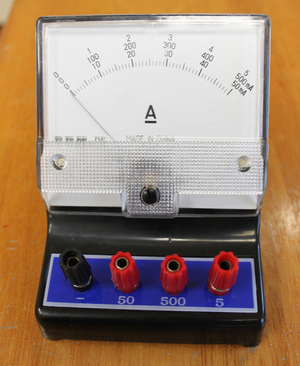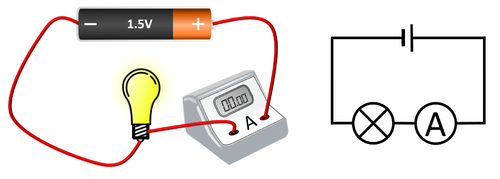Difference between revisions of "Ammeter"
| Line 8: | Line 8: | ||
: An ideal [[ammeter]] has zero [[Electrical Resistance|resistance]] because otherwise adding an [[ammeter]] to a [[circuit]] would change the [[Electrical Current|current]]. | : An ideal [[ammeter]] has zero [[Electrical Resistance|resistance]] because otherwise adding an [[ammeter]] to a [[circuit]] would change the [[Electrical Current|current]]. | ||
: [[Ammeter]]s can be [[Analogue Ammeter|analogue]] with a needle pointing to numbers on a dial or it can be [[Digital Ammeter|digital]] with a number display. | : [[Ammeter]]s can be [[Analogue Ammeter|analogue]] with a needle pointing to numbers on a dial or it can be [[Digital Ammeter|digital]] with a number display. | ||
| + | {| class="wikitable" | ||
| + | |- | ||
| + | |[[File:Circuit+Diagram2.png|center|500px]] | ||
| + | |- | ||
| + | | style="height:20px; width:200px; text-align:center;" |An '''ammeter''' placed in [[Series Circuit|series]] with a [[Electrical Bulb|bulb]]. | ||
| + | |} | ||
Revision as of 10:47, 25 October 2018
Key Stage 3
Meaning

A picture showing an analogue ammeter.
An ammeter is a measuring device used to measure electrical current.
About Ammeters
- Ammeters are added in series to a circuit.
- An ideal ammeter has zero resistance because otherwise adding an ammeter to a circuit would change the current.
- Ammeters can be analogue with a needle pointing to numbers on a dial or it can be digital with a number display.
| An ammeter placed in series with a bulb. |
